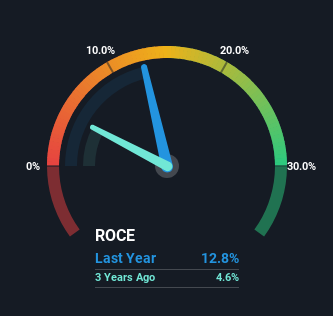- United States
- /
- Hospitality
- /
- NYSE:EAT
Brinker International (NYSE:EAT) May Have Issues Allocating Its Capital

What trends should we look for it we want to identify stocks that can multiply in value over the long term? In a perfect world, we'd like to see a company investing more capital into its business and ideally the returns earned from that capital are also increasing. Ultimately, this demonstrates that it's a business that is reinvesting profits at increasing rates of return. In light of that, when we looked at Brinker International (NYSE:EAT) and its ROCE trend, we weren't exactly thrilled.
Understanding Return On Capital Employed (ROCE)
If you haven't worked with ROCE before, it measures the 'return' (pre-tax profit) a company generates from capital employed in its business. Analysts use this formula to calculate it for Brinker International:
Return on Capital Employed = Earnings Before Interest and Tax (EBIT) ÷ (Total Assets - Current Liabilities)
0.13 = US$246m ÷ (US$2.5b - US$579m) (Based on the trailing twelve months to March 2024).
So, Brinker International has an ROCE of 13%. In absolute terms, that's a satisfactory return, but compared to the Hospitality industry average of 10% it's much better.
Check out our latest analysis for Brinker International

Above you can see how the current ROCE for Brinker International compares to its prior returns on capital, but there's only so much you can tell from the past. If you'd like to see what analysts are forecasting going forward, you should check out our free analyst report for Brinker International .
What Does the ROCE Trend For Brinker International Tell Us?
On the surface, the trend of ROCE at Brinker International doesn't inspire confidence. Over the last five years, returns on capital have decreased to 13% from 29% five years ago. However it looks like Brinker International might be reinvesting for long term growth because while capital employed has increased, the company's sales haven't changed much in the last 12 months. It may take some time before the company starts to see any change in earnings from these investments.
On a related note, Brinker International has decreased its current liabilities to 23% of total assets. That could partly explain why the ROCE has dropped. What's more, this can reduce some aspects of risk to the business because now the company's suppliers or short-term creditors are funding less of its operations. Some would claim this reduces the business' efficiency at generating ROCE since it is now funding more of the operations with its own money.
Our Take On Brinker International's ROCE
Bringing it all together, while we're somewhat encouraged by Brinker International's reinvestment in its own business, we're aware that returns are shrinking. Since the stock has gained an impressive 80% over the last five years, investors must think there's better things to come. However, unless these underlying trends turn more positive, we wouldn't get our hopes up too high.
On a final note, we've found 2 warning signs for Brinker International that we think you should be aware of.
If you want to search for solid companies with great earnings, check out this free list of companies with good balance sheets and impressive returns on equity.
Valuation is complex, but we're here to simplify it.
Discover if Brinker International might be undervalued or overvalued with our detailed analysis, featuring fair value estimates, potential risks, dividends, insider trades, and its financial condition.
Access Free AnalysisHave feedback on this article? Concerned about the content? Get in touch with us directly. Alternatively, email editorial-team (at) simplywallst.com.
This article by Simply Wall St is general in nature. We provide commentary based on historical data and analyst forecasts only using an unbiased methodology and our articles are not intended to be financial advice. It does not constitute a recommendation to buy or sell any stock, and does not take account of your objectives, or your financial situation. We aim to bring you long-term focused analysis driven by fundamental data. Note that our analysis may not factor in the latest price-sensitive company announcements or qualitative material. Simply Wall St has no position in any stocks mentioned.
About NYSE:EAT
Brinker International
Engages in the ownership, development, operation, and franchising of casual dining restaurants in the United States and internationally.
Solid track record with reasonable growth potential.

